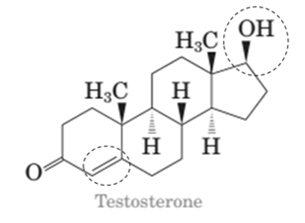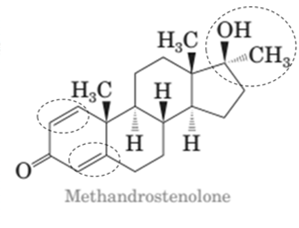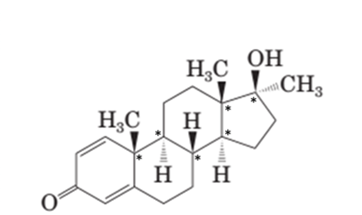
(a)
Interpretation:
The differences in the structural formula of testosterone and methandrostenolone should be determined along with


Concept Introduction:
Steroids are the third major class of lipids. These are the compounds containing the following ring system:

Answer to Problem 17.76P
Both methandrostenolone and testosterone hormone contains hydroxyl functional group (alcohol) and carbonyl functional group (kentone).
In the structural formula of testosterone hormone, there is only one double bond and it has only one methyl group attached to cyclopentane ring whereas in methandrostenolone there are two double bonds and two methyl groups are attached to the cyclopentane ring.
Explanation of Solution
Testosterone and methandrostenolone both the hormones contain one −OH group attached to cyclopentane ring and one >C=O group in cyclohexene ring. Therefore both alcoholic and
In the structure of testosterone there is only a double bond in cyclohexene ring having ketonic group and no methyl group is present on the carbon of cyclopentane ring having alcoholic group as shown:

In the structure of methandrostenolone, there are two double bonds in cyclohexene ring having ketonic group and one methyl group attached on the carbon of cyclopentane ring having alcoholic group as shown:

(b)
Interpretation:
In both the given hormones mark all the stereocenters and state the number of stereoisomer possible for each.


Concept Introduction:
Stereoisomers are the compounds that are differ only in the spatial arrangement of their atoms. Each stereoisomer has at least one stereocenter. A stereocenter is a tetrahedral carbon atom that has four different groups bonded to it. For a molecule with n sterocenters, a maximum of
Answer to Problem 17.76P
Stereocenters in testosterone:
Since testosterone has six stereocenters therefore it has 64 possible stereoisomers.
Stereocenters in methandrostenolone:
Since methandrostenolone has six stereocenters therefore it has 64 possible stereoisomers.
Explanation of Solution
A stereocenter is a tetrahedral carbon atom that has four different groups bonded to it.
Stereocenters in testosterone:
In testosterone there are six stereocenters.

For a molecule with n stereocenter, a maximum of
Stereocenters in methandrostenolone:
In methandrostenolone there are six stereocenters.

For a molecule with n stereocenter, a maximum of
Want to see more full solutions like this?
Chapter 17 Solutions
Introduction to General, Organic and Biochemistry
- 16-28 Following is the structural formula of metformin, the hydrochloride salt of which is marketed as the antidiabetic medication Glucophage. Metformin was introduced into clinical practice in the United States in 1995 for the treatment of type 2 diabetes. More than 25 million prescriptions for this drug were written in 2000, making it the most commonly prescribed brand-name diabetes medication in the nation. NH NH H3(\ 3 N N Nh2ch3 h Metformin Complete the Lewis structure for metformin, showing all valence electrons. Which nitrogen is the most likely site of protonation? Draw the structural formula of Glucophage.arrow_forward17-14 Following are structural formulas for two steroid hormones. (a) Name the functional groups in each. (b) Mark all stereocenters in each hormone and state how many stereoisomers are possible for each.arrow_forward16-58 Following is a structural formula of desosamine, a sugar component of several macrolide antibiotics, including the erythromycins. The configuration shown here is that of the natural product. Erythromycin is produced by a strain of Streptomyces erythreus originally found in a soil sample from the Philippine Archipelago. ch3 T Desosamine Name all the functional groups in desosamine. (Chapter 10) How many stereocenters are present in desosamine? How many stereoisomers are possible for it? How many pairs of enantiomers are possible for it? Draw the alternative chair conformations for desosamine and label which groups are equatorial and which are axial. (d > Which of the alternative chair conformations for desosamine is more stable?arrow_forward
- 16-54 Several poisonous plants, including Atropa belladonna, contain the alkaloid atropine. The name “belladonna” (which means “beautiful lady”) probably comes from the fact that Roman women used extracts from this plant to make themselves more attractive. Atropine is widely used by ophthal mologists and optometrists to dilate the pupils for eye examination. Classify the amino group in atropine as primary, secondary, or tertiary. Locate all stereocenters in atropine. Account for the fact that atropine is almost insoluble in water (1 g in 455 mL of cold water) but atropine hydrogen sulfate is very soluble (1 g in 5 mL of cold water). Account for the fact that a dilute aqueous solution of atropine is basic (pH approximately 10.0).arrow_forward17-54 Following is the structure of immunosuppressant FK-506, a molecule shown to disrupt calcineurin-mediated signal transduction in T-lymphocytes. (a) There are three carbon—carbon double bonds present in this molecule. Which of the three has the potential for cis/trans isomerism? Assign a cis or trans con?guration to each carbon-carbon double bond that has this possibility. (b) How many stereocenters are present in this molecule? How many stereoisomers are possible for it? (c) Are there any aromatic components in this molecule? (d) Consider the two carbon atoms marked with asterisks. Assign an R or S con?guration of each stereocenter. (e) Because of the presence of a 21-member ring, this molecule is described as a macrocycle. This ring is fashioned by three types of bonds, several carbon-carbon bonds, one ester, one hemiacetal, and one amide. Locate the ester and the hemiacetal. (f) Draw the structural formula of the long chain compound that would result if the hemiacetal were to be cleaved to an alcohol and a carbonyl group.arrow_forward18-18 Propanoic acid and methyl acetate are constitutional isomers, and both are liquids at room temperature. One of these compounds has a boiling point of 141°C; the other has a boiling point of 57°C. Which compound has which boiling point? Explain.arrow_forward
- 18-6 Name and draw structural formulas for the four carboxylic acids with the molecular formula C5H10O2. Which of these carboxylic acids are chiral?arrow_forward17-15 Draw structural formulas for the four aldehydes with the molecular formula C5H10O. Which of these aldehydes are chiral?arrow_forward17-12 Is it possible for the carbon atom of a carbonyl group to be a stereocenter? Explain.arrow_forward
- 17-69 Propanal (bp 49°C) and 1-propanol (bp 97°C) have about the same molecular weight, yet their boiling points differ by almost 50°C. Explain this fact.arrow_forward17-70 What simple chemical test could you use to distinguish between the members of each pair of com pounds? Tell what you would do, what you would expect to observe, and how you would interpret your experimental observation. (a) Benzaldehyde and cyclohexanone (b) Acetaldehyde and acetonearrow_forward17-29 Why can’t two molecules of acetone form a hydrogen bond with each other?arrow_forward
 Introduction to General, Organic and BiochemistryChemistryISBN:9781285869759Author:Frederick A. Bettelheim, William H. Brown, Mary K. Campbell, Shawn O. Farrell, Omar TorresPublisher:Cengage Learning
Introduction to General, Organic and BiochemistryChemistryISBN:9781285869759Author:Frederick A. Bettelheim, William H. Brown, Mary K. Campbell, Shawn O. Farrell, Omar TorresPublisher:Cengage Learning
